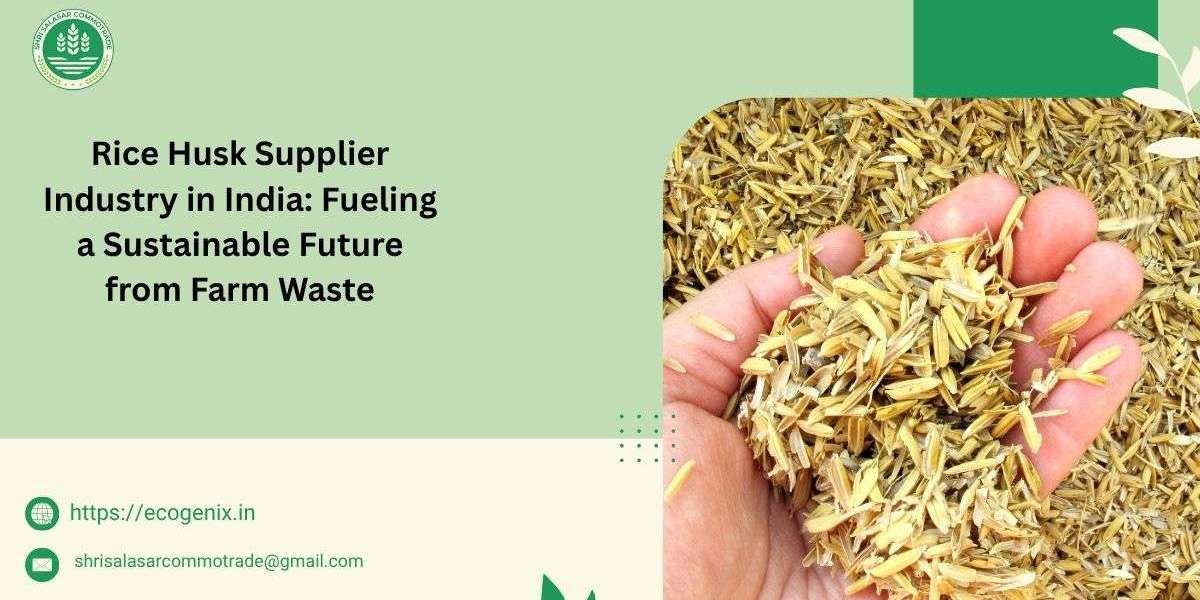Introduction
India, being one of the largest producers of rice in the world, generates an enormous volume of agricultural by-products. Among these, rice husk, the hard protective covering removed during the milling of rice, is often discarded or burned. For decades, it was considered waste. But today, in the era of sustainability and circular economy, rice husk has transformed into a valuable raw material with multiple industrial applications.
This transformation has opened doors for a whole new segment of agribusiness rice husk suppliers. These entrepreneurs and businesses collect, process, and distribute rice husk to industries across sectors such as energy, construction, and agriculture. In this article, we explore a unique and in-depth perspective on the rice husk supplier industry in India, focusing on its business potential, market demand, sustainability impact, and future outlook.
What is Rice Husk?
Rice husk (also known as rice hull) is the outer layer of the paddy grain, removed during the milling process. It constitutes around 20% of the paddy weight, and India, producing over 120 million tonnes of rice annually, generates roughly 24 million tonnes of rice husk each year.
Composition of Rice Husk:
- Cellulose – 35%
- Lignin – 25%
- Silica – 15–20%
- Moisture – 8–12%
These components make rice husk highly combustible, lightweight, and rich in silica, which is useful for various industrial applications.
The Rise of the Rice Husk Supplier Industry
Traditionally, rice husk was used as low-grade fuel in rural kitchens or dumped in landfills. However, with the rising demand for eco-friendly alternatives, industries started realizing the economic and environmental value of rice husk.
Key Drivers Behind the Growth:
- Rising energy costs prompting industries to use biomass fuels
- Sustainable construction materials needing silica-rich alternatives
- Eco-conscious manufacturing practices in sectors like cement, steel, and agriculture
- Government policies encouraging biomass utilization and zero-waste farming
These trends have led to the rise of organized rice husk suppliers who act as critical links between rice mills and industries.
Major Uses of Rice Husk Across Industries
Bioenergy and Biomass Fuel
Rice husk is widely used as a renewable fuel in:
- Biomass power plants
- Industrial boilers
- Pellet and briquette manufacturing
Its high calorific value and low ash content make it a cost-effective and eco-friendly fuel source.
Rice Husk Ash (RHA) and Silica
When rice husk is burned under controlled conditions, it produces Rice Husk Ash, which contains up to 85–95% amorphous silica. RHA is used in:
- Concrete and cement as a pozzolanic material
- Glass and ceramics
- High-performance insulation
Animal Bedding and Feed Additive
Due to its absorbent nature, dried husk is used as:
- Bedding for poultry and cattle
- A fiber additive in animal feed (after processing)
Agriculture and Soil Conditioning
Rice husk improves soil aeration and drainage. It’s also used in:
- Organic farming as mulch
- Composting and potting mixtures
Eco-Friendly Packaging and Products
Processed rice husk is now used in:
- Biodegradable cutlery and plates
- Eco-bricks and particle boards
- Wood-plastic composites for furniture
Who Are Rice Husk Suppliers?
Rice husk suppliers are businesses that source husk from rice mills, process it (drying, packaging, converting to ash or pellets), and supply it to different industries. Their operations may include:
- Collection and bulk storage
- Drying and moisture control
- Crushing, pelletizing, or ashing
- Quality testing (especially silica content)
- Packaging and logistics
- Export documentation and clearance
Some operate locally, supplying within districts or states, while others act as exporters catering to international markets.
Key Challenges in the Rice Husk Supply Chain
Despite its potential, the rice husk supply is not without challenges:
- High logistics cost due to low bulk density
- Moisture sensitivity – requires careful storage and drying
- Price fluctuations – seasonal variations in rice milling
- Lack of infrastructure for processing in rural areas
- Limited awareness about quality standards among small suppliers
Overcoming these challenges requires investment in technology, better logistics, and awareness campaigns.
Government Support and Policies
To encourage bioeconomy and reduce agri-waste pollution, the Indian government provides:
- Subsidies for biomass boilers and briquette machines
- Zero-waste farming schemes under PM-KUSUM and RKVY
- Incentives for startups working in agri-waste innovation
- Tax benefits for exporters of biomass fuels
States like Punjab, Haryana, and UP also support rice husk use to curb stubble burning.
Role in Sustainability and Climate Goals
Rice husk suppliers contribute to:
Waste to Wealth Conversion: Turning agricultural residue into a useful industrial input
Carbon Neutral Energy: Biomass use reduces dependency on fossil fuels
Eco-friendly Construction: Silica from husk ash replaces sand and cement
Rural Employment: Creates jobs in collection, transport, and processing
Future Outlook: What Lies Ahead?
With rising awareness and demand for renewable resources, the rice husk supplier industry is expected to grow by 10–15% annually.
Emerging Trends:
- AI-based moisture monitoring in storage
- Blockchain for supply chain traceability
- Value-added products like activated carbon, nano-silica
- Collaborations with carbon credit platforms
The future belongs to sustainable raw material suppliers, and rice husk is leading the way.
Note:- Purchase affordable rice husk ash in India
Conclusion
The rice husk supplier industry is a remarkable example of how something once considered agricultural waste can become a pillar of green economy, rural entrepreneurship, and industrial innovation. With the right infrastructure, policy support, and market linkages, rice husk suppliers in India can fuel a future that’s cleaner, smarter, and more sustainable.
If you’re looking to enter a business that is eco-friendly, in-demand, and future-proof, becoming a rice husk supplier may be your golden opportunity—from the grain fields to global green markets.



